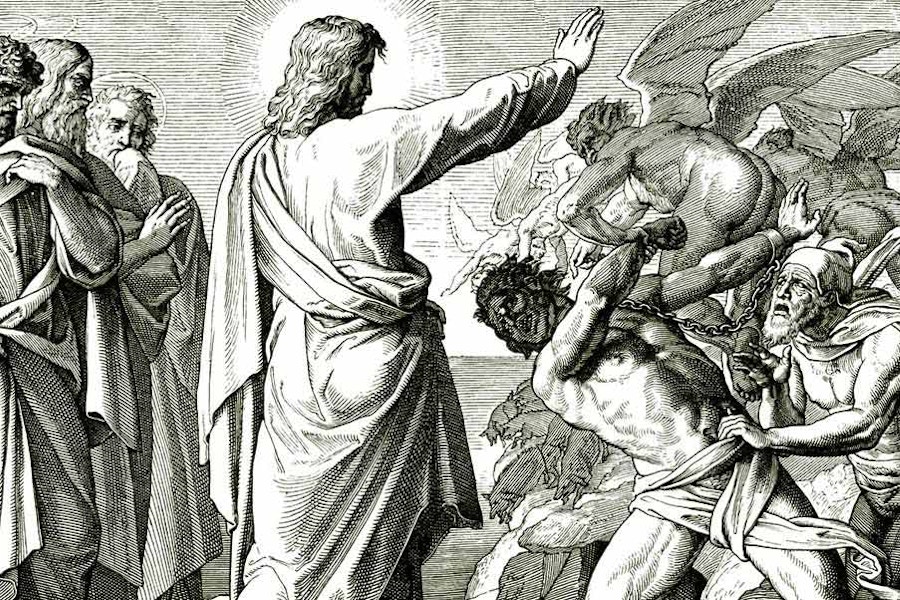Introductory Note:
As we continue to grapple with the ever-unfolding mystery of Jesus this week, G.K. Chesterton joins us to lend his own inimitable voice to the challenge. Here, in this excerpt from his masterwork on the history of mankind, Christ, and Christianity The Everlasting Man, Chesterton contends that our common perception of “Gentle Jesus, meek and mild” is true, but incomplete. He encourages us to read the New Testament with the eyes of a stranger to earth who comes to the story of Jesus as told in the Gospels with no preconceptions, no filters, no doctrine. Chesterton thinks that we will meet a startling Jesus within those pages—one who, as C.S. Lewis would put it years later, is truly not a tame lion, but one who is very good.
Renovaré Team
 Excerpt from The Collected Works of G.K. Chesterton, Vol. 2
Excerpt from The Collected Works of G.K. Chesterton, Vol. 2
We have all heard people say a hundred times over, for they seem never to tire of saying it, that the Jesus of the New Testament is indeed a most merciful and humane lover of humanity, but that the Church has hidden this human character in repellent dogmas and stiffened it with ecclesiastical terrors till it has taken on an inhuman character. This is, I venture to repeat, very nearly the reverse of the truth. The truth is that it is the image of Christ in the churches that is almost entirely mild and merciful. It is the image of Christ in the Gospels that is a good many other things as well.
The figure in the Gospels does indeed utter in words of almost heart-breaking beauty his pity for our broken hearts. But they are very far from being the only sort of words that he utters. Nevertheless they are almost the only kind of words that the Church in its popular imagery ever represents him as uttering. That popular imagery is inspired by a perfectly sound popular instinct. The mass of the poor are broken, and the mass of the people are poor, and for the mass of mankind the main thing is to carry the conviction of the incredible compassion of God.
But nobody with his eyes open can doubt that it is chiefly this idea of compassion that the popular machinery of the Church does seek to carry. The popular imagery carries a great deal to excess the sentiment of ‘Gentle Jesus, meek and mild.’ It is the first thing that the outsider feels and criticizes in a Pieta or a shrine of the Sacred Heart. As I say, while the art may be insufficient, I am not sure that the instinct is unsound. In any case there is something appalling, something that makes the blood run cold, in the idea of having a statue of Christ in wrath. There is something insupportable even to the imagination in the idea of turning the corner of a street or coming out into the spaces of a marketplace, to meet the petrifying petrifaction of that figure as it turned upon a generation of vipers, or that face as it looked at the face of a hypocrite. The Church can reasonably be justified therefore if she turns the most merciful face or aspect towards men; but it is certainly the most merciful aspect that she does turn.
And the point is here that it is very much more specially and exclusively merciful than any impression that could be formed by a man merely reading the New Testament for the first time. A man simply taking the words of the story as they stand would form quite another impression; an impression full of mystery and possibly of inconsistency; but certainly not merely an impression of mildness. It would be intensely interesting; but part of the interest would consist in its leaving a good deal to be guessed at or explained.
It is full of sudden gestures evidently significant except that we hardly know what they signify, of enigmatic silences; of ironical replies. The outbreaks of wrath, like storms above our atmosphere, do not seem to break out exactly where we should expect them, but to follow some higher weather-chart of their own. The Peter whom popular Church teaching presents is very rightly the Peter to whom Christ said in forgiveness, ‘Feed my lambs.’ He is not the Peter upon whom Christ turned as if he were the devil, crying in that obscure wrath, ‘Get thee behind me, Satan.’ Christ lamented with nothing but love and pity over Jerusalem which was to murder him. We do not know what strange spiritual atmosphere or spiritual insight led him to sink Bethsaida lower in the pit than Sodom.
I am putting aside for the moment all questions of doctrinal inferences or expositions, orthodox or otherwise; I am simply imagining the effect on a man’s mind if he did really do what these critics are always talking about doing; if he did really read the New Testament without reference to orthodoxy and even without reference to doctrine. He would find a number of things which fit in far less with the current unorthodoxy than they do with the current orthodoxy.
He would find, for instance, that if there are any descriptions that deserved to be called realistic, they are precisely the descriptions of the supernatural. If there is one aspect of the New Testament Jesus in which he may be said to present himself eminently as a practical person, it is in the aspect of an exorcist. There is nothing meek and mild, there is nothing even in the ordinary sense mystical, about the tone of the voice that says ‘Hold thy peace and come out of him.’ It is much more like the tone of a very business-like lion-tamer or a strong-minded doctor dealing with a homicidal maniac. But this is only a side issue for the sake of illustration; I am not now raising these controversies; but considering the case of the imaginary man from the moon to whom the New Testament is new.
Excerpted from G.K. Chesterton’s The Everlasting Man (pp. 139 – 140), in the public domain via Jesus.org.


